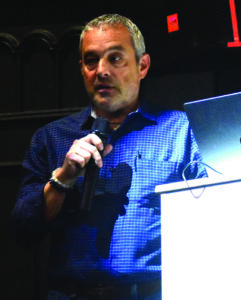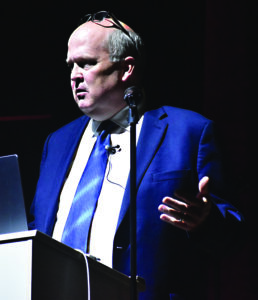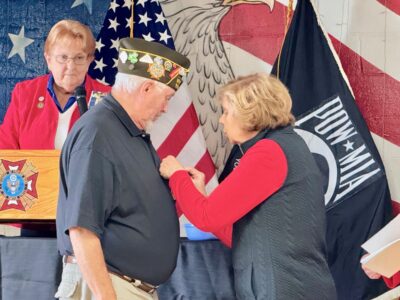Town hall regarding Norfolk Southern settlement held
- Seth Katz, one of the attorneys who brokered last week’s class-action principle agreement with Norfolk Southern, speaks to area residents during a town hall meeting at the Columbiana Theater on Monday. (Photo by Stephanie Elverd, Special to The Times)
- Attorney Mikal Watts, a member of Erin Brockovich’s East Palestine Justice team, speaks to area residents during a town hall meeting at the Columbiana Theater on Monday. (Photo by Stephanie Elverd, Special to The Times)
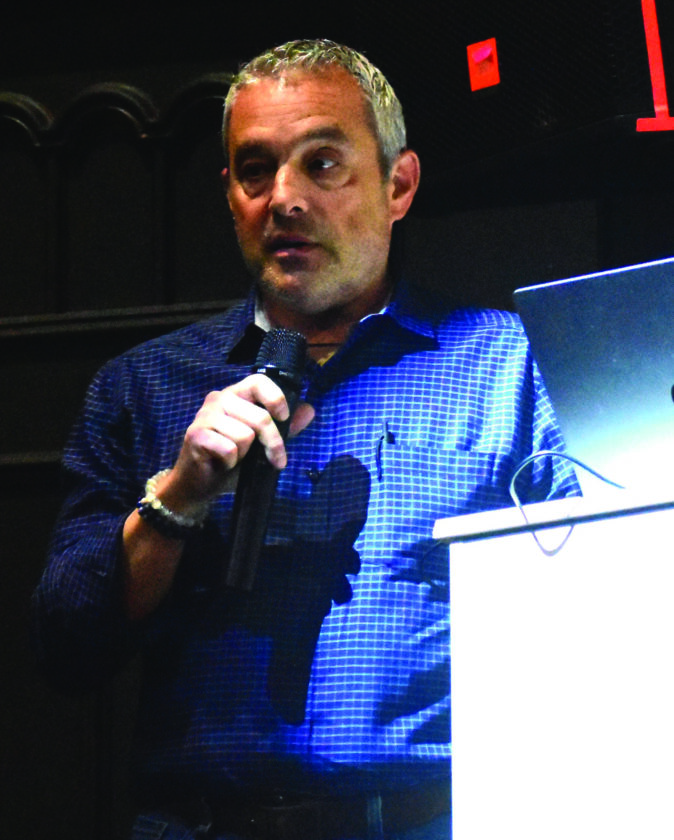
Seth Katz, one of the attorneys who brokered last week’s class-action principle agreement with Norfolk Southern, speaks to area residents during a town hall meeting at the Columbiana Theater on Monday. (Photo by Stephanie Elverd, Special to The Times)
COLUMBIANA — The next step in settling a class-action lawsuit against Norfolk Southern over last year’s train derailment is to file a motion to convince the U.S. District Court in Youngstown that the $600 million agreement is “fair, reasonable and adequate,” attorney Seth Katz told residents during a town hall meeting this week.
Katz, who helped broker last week’s class-action principle agreement with the railroad company, and Mikal Watts of East Palestine Justice, spent most of Monday’s hour-long informational session at the Columbiana Theater trying to convince residents of the same thing.
“Your job is to look at the evidence and decide what you want to do. My job is to not sugarcoat the evidence,” Watts said. “We found what we found. The liability evidence is really strong. One of the strongest liability cases we’ve ever seen. The damages evidence with respect to personal injury for most of you is not strong. It makes the best recovery achievable for property damage, a loss of value of your real estate, the cost to clean up versus recovering a bunch of money for a potential cancer that may or may not come.”
Watts explained that in order to collect for personal injury, causation must be proved. In other words, it’s not enough to show that the defendant was negligent. While many believe they have suffered adverse health effects due to the derailment and intentional chemical release, Watts said proving it is not as easy.
Residents must show that medical symptoms correspond with derailment-related contamination. Reported or documented symptoms matter little if environmental testing does not show the probability of chemical exposure.
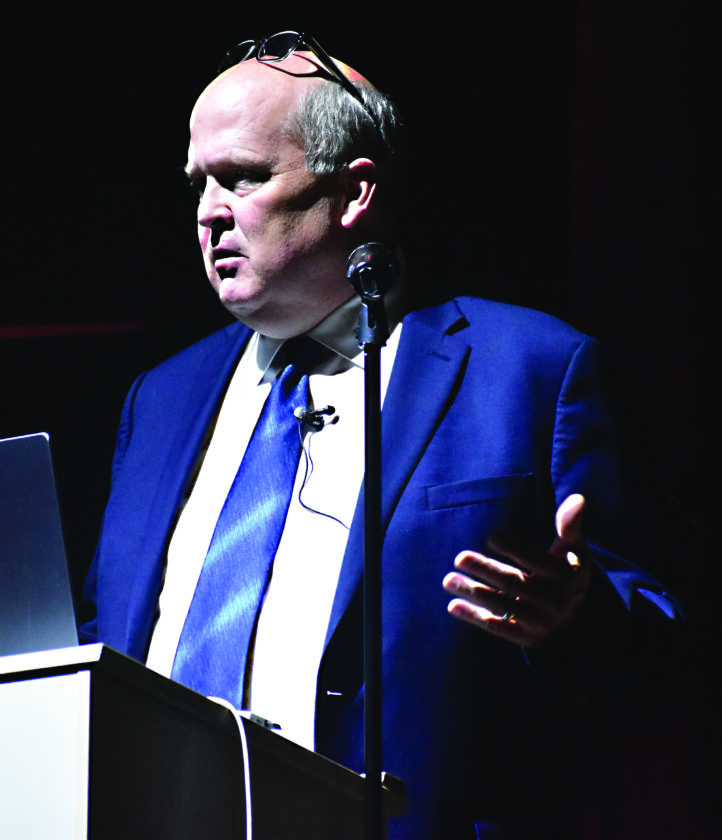
Attorney Mikal Watts, a member of Erin Brockovich’s East Palestine Justice team, speaks to area residents during a town hall meeting at the Columbiana Theater on Monday. (Photo by Stephanie Elverd, Special to The Times)
“We know what chemicals got released. We know what they were. We know what cars they were in. We know how much got released. And we know it, in effect, created dioxin which is not a good thing,” Watts said.
“But that’s not enough to win a lawsuit in an environmental tort case. You have to show not only that it got released, but through air modeling and soil sampling that it actually ended up in the particular properties where the plaintiffs were. You have to show the level of that together with the epidemiology to be able to prove some causation for the injuries that were alleged.
That is a different kettle of fish than saying my property has been damaged or my property value has gone down because of all the negative press and because of the pollution we know was here.”
Watts did not disclose the results of what was described as extensive testing — those results will eventually be made public through legal proceedings and discovery — but he did reveal that the results showed “prevalent” contaminants at or near the derailment site.
Residents who lived or worked within 10 miles of “ground zero” are considered to Class 1 and have the strongest claims based on loss of enjoyment of their properties, emotional distress, loss of property value, lost wages and the potential cost of future medical care. Claimants that fall into that class will be entitled to a bigger piece of the settlement based on a formula.
“There has been misreporting that you just take the $600 million and divide it by the number of people that live in the 20-mile radius, and that couldn’t be further from the truth,” Katz said.
“There are claim forms that have to be submitted with different criteria that is still being finalized but proximity to the derailment site will be one of the most important factors in all this.”
Class 2 claimants are considered to be residents or employees within 10 to 20 miles of the derailment where contamination was found to be “less prevalent” but still allows claims based on the same criteria as Class 1.
The criteria will include location/distance from the derailment site, household composition (number of adults and children), length of time displaced or relocated, time missed from work, out-of-pocket expenses and derailment-related benefits already received.
Class 3 is for business owners within 20 miles. Business owners must show a loss of revenue in 2023 compared to what was reflected in 2022 tax documents.
As for areas outside of the 20-mile radius, Watts said contamination was “virtually non-existent” that far away which means the chance of success of claims from individuals in those locations is “virtually non-existent” as well.
Class 1 claimants can also opt-in to the “voluntary personal injury program.” That option is only open to individuals within the first 10 miles of ground zero for adverse health impacts from the derailment suffered in the past, present or future.
Opting in means forever releasing Norfolk Southern of all personal injury claims related to the derailment. That will allow for additional compensation based on, among other things, proximity to the derailment, duration of health symptoms, medical treatment sought or received and any formal diagnosis given.
Symptoms reported have been wide-ranging — from persistent nosebleeds and rashes to respiratory and digestive ailments to cognitive issues and seizure-like episodes.
No provision was included in the settlement requiring Norfolk Southern to monitor public health now or in the future.
“The court dismissed the claim for medical monitoring (against Norfolk Southern) but the payments for medical monitoring are included in this component of the settlement,” Katz said. “If you get an award in the settlement that falls into this bucket, you can use the money for whatever you want, but the claims that are being asserted against Norfolk Southern are being released. That means they are going to pay this money, and that’s it.”
Residents can choose to not take part in the “voluntary personal injury program” but continue with claims for property damage under the class-action settlement. That will reserve an individual’s right to sue for personal injury if they choose to do so in the future.
The first lawsuit, which was later consolidated with 30 others to create the class action, was filed on Feb. 7, 2023 — just days after the derailment and one day after the vent-and-burn. The settlement amount was proposed by mediator Layn Phillips, a former United States attorney, former U.S. District Judge and founder of a dispute resolution firm which focuses on the mediation of complex disputes.
If Judge Benita Pearson accepts the settlement, the court will give preliminary approval. Once that is received, the claim process can begin, and residents impacted can decide whether to participate or not.
It was stressed Monday that the pending agreement is not an admission of a liability, wrongdoing, or fault on behalf of the railroad — common verbiage in most settlements.
“Where I come from when somebody parts with $600 million that tells you all you need to know,” Watts said.
“As with any settlement, people say ‘is that enough.’ I can tell you this is the largest railroad settlement in the history of the country by a factor of four, I think,” Watts said. “It’s unprecedented, but is it enough? That’s a decision you all are going to have to make.”

